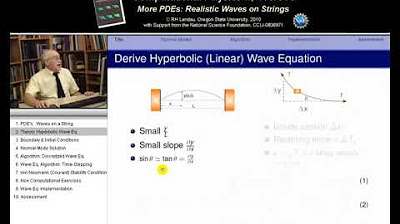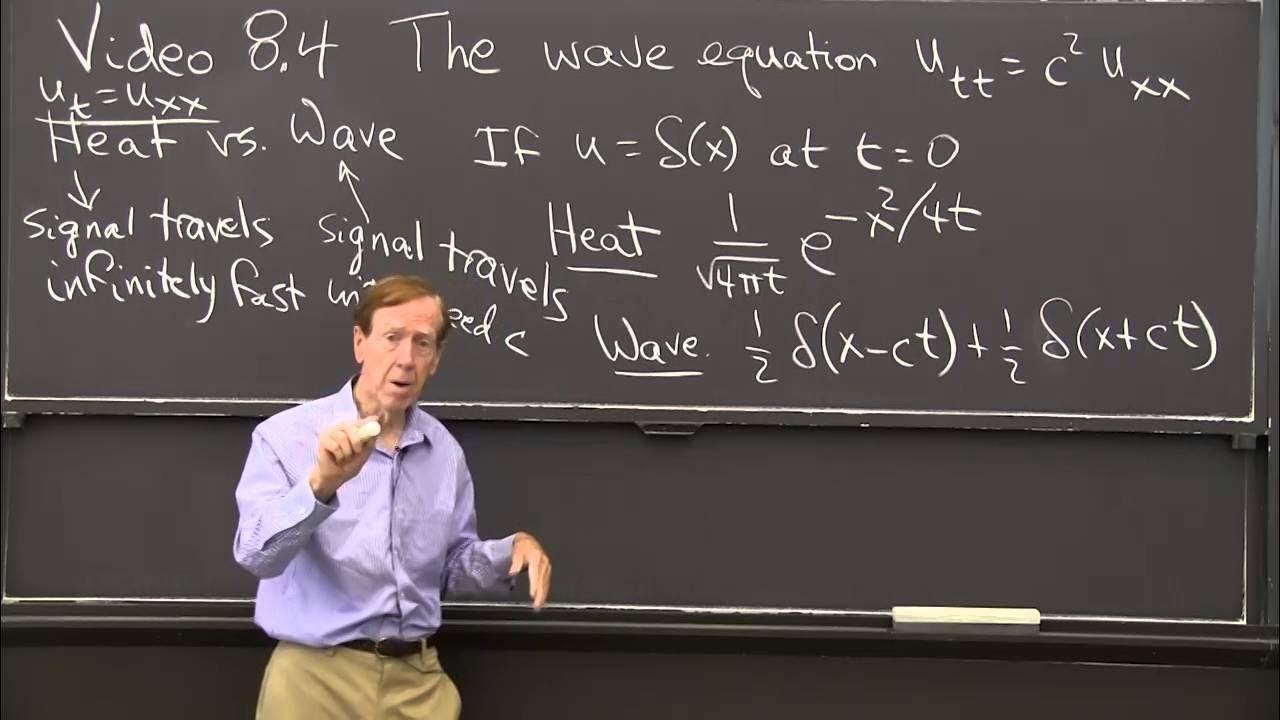20.4 Heat Equation via Crank-Nickelson
TLDRThis lecture delves into the Crank-Nicolson method, an advanced leapfrog time-stepping technique for solving heat flow problems with higher precision. The method involves solving the heat equation at half time steps using central differences for both time and space derivatives, resulting in a more accurate solution at the cost of increased complexity. The lecture explains the algorithm development, the benefits of the method, and its stability, highlighting the use of tri-diagonal matrix techniques for efficient computation. The speaker encourages students to experiment with the method, emphasizing the importance of understanding and improving algorithms in scientific computing.
Takeaways
- 🔍 The lecture discusses the Crank-Nicolson method, an improvement over the leapfrog method for time stepping in heat flow problems.
- 📚 The Crank-Nicolson method offers higher precision at the cost of increased complexity in the algorithm.
- 🔧 The method uses a central difference for the time derivative, which is more accurate than the forward difference used in the leapfrog method.
- 🕒 The Crank-Nicolson method involves solving for temperatures at half time steps, providing a more accurate approximation.
- 🔄 The 'split time step' concept is introduced, where the solution is found at a time in between full time steps.
- 📉 The problem of initializing the method with only one row of data at time zero is addressed by using the known boundary conditions.
- 🔗 The heat equation is reformulated in a discrete form to be solved at half time steps, involving values on the lattice points.
- 📝 The method results in an implicit solution that requires solving a matrix equation, which can be done using standard linear algebra techniques.
- 📊 The Crank-Nicolson method is unconditionally stable, as demonstrated through von Neumann stability analysis.
- 🔍 The matrix involved in the method is tri-diagonal, which allows for special solving techniques that are more efficient than general matrix inversion.
- 💻 The lecture provides a sample Python code for solving tri-diagonal matrix equations, emphasizing the efficiency of these specialized methods.
Q & A
What is the Crank-Nicolson method discussed in the script?
-The Crank-Nicolson method is an improved leapfrog method used for solving differential equations, particularly useful for heat flow problems. It provides higher precision in time stepping by using a central difference approximation for the time derivative, resulting in a more accurate solution at the cost of increased complexity.
What is the main issue with the ordinary leapfrog method mentioned in the script?
-The main issue with the ordinary leapfrog method is its inaccuracy due to the use of a forward difference method for the time derivative, which is not as precise as a central difference method.
How does the Crank-Nicolson method improve upon the leapfrog method?
-The Crank-Nicolson method improves upon the leapfrog method by using a central difference for the time derivative, which is evaluated at the midpoint of the time step, thus providing a more accurate approximation.
What is the significance of the 'split time step' in the Crank-Nicolson method?
-The 'split time step' in the Crank-Nicolson method allows for the evaluation of the time derivative at a time halfway between the current and next time step, which contributes to the method's higher precision.
What is the role of the tri-diagonal matrix in solving the Crank-Nicolson equations?
-The tri-diagonal matrix is used to represent the system of linear equations resulting from the discretization of the heat equation in the Crank-Nicolson method. Solving this matrix equation allows for the calculation of temperature values at future time steps.
Why is the Crank-Nicolson method considered stable according to the script?
-The Crank-Nicolson method is considered stable because, through von Neumann stability analysis, it is shown that the amplitude of the eigenmodes always remains less than one, regardless of the values of delta x or delta t, ensuring convergence.
What is the advantage of using special matrix techniques for tri-diagonal matrices?
-Special matrix techniques for tri-diagonal matrices are advantageous because they are faster and more accurate than general linear algebra techniques. This is due to the sparsity of the matrix, which contains significantly fewer elements to process.
How does the script describe the process of solving a tri-diagonal matrix equation?
-The script describes a three-step process for solving a tri-diagonal matrix equation: reducing the matrix to a form where all diagonals are one, solving for the variables explicitly, and then using these solutions to find the temperature values at future times.
What is the practical implication of using the Crank-Nicolson method for solving heat flow problems?
-The practical implication of using the Crank-Nicolson method is that it provides a more accurate solution for heat flow problems with a stable and efficient computation, which is particularly useful for complex or large-scale problems.
How does the script suggest one should approach improving algorithms?
-The script suggests that one should approach improving algorithms by understanding the limitations of existing methods, exploring more precise mathematical techniques, and then evaluating the trade-offs in terms of complexity and computational efficiency.
What is the script's suggestion for further learning and practice after understanding the Crank-Nicolson method?
-The script suggests that learners should try solving similar heat flow problems using the provided code or library functions, check for stability, and compare the speed and accuracy of the Crank-Nicolson method with the ordinary leapfrog method.
Outlines
🔍 Introduction to Crank-Nicolson Method for Heat Flow
The script begins with an introduction to the Crank-Nicolson method, an improved leapfrog method for solving heat flow problems with higher precision. The lecturer discusses the limitations of the standard leapfrog method due to its use of forward difference for the time derivative, which is less accurate. The Crank-Nicolson method addresses this by using a central difference for both time and space derivatives, resulting in a more accurate solution at the cost of increased complexity. The lecturer sets up a problem involving a bar with an initial temperature of 100 degrees Celsius, with insulated ends kept at 0 degrees Celsius, and explains the goal of finding the time-dependent temperature distribution along the bar.
📚 Algorithm Development and Crank-Nicolson Method Explanation
This section delves into the algorithmic development of the Crank-Nicolson method. The lecturer explains how the method uses a split time step to evaluate the time derivative at the midpoint of the interval, rather than at the discrete time steps. This approach leads to a more accurate approximation of the temperature at time t + delta t/2. The script describes the process of rewriting the heat equation in finite difference form, with the aim of solving for temperatures at half time steps based on lattice values at full time steps. The lecturer also discusses the implicit solution and the need to solve a system of algebraic equations to advance the solution in time.
🔧 Stability Analysis and Solving Tri-Diagonal Matrix Equations
The script continues with a discussion on the stability of the Crank-Nicolson method, highlighting its convergence and stability for any choice of delta x or delta t. The lecturer then introduces the concept of a tri-diagonal matrix and explains the special techniques used to solve such matrices efficiently. The tri-diagonal matrix is characterized by three diagonals with non-zero elements and zeros elsewhere. The script outlines the steps to reduce the matrix to a form where the diagonal elements are one, allowing for an explicit solution without the need for matrix inversion. The efficiency of these techniques is emphasized, as they significantly reduce computational complexity compared to standard linear algebra methods.
💻 Practical Implementation and Comparison of Time Stepping Methods
The final paragraph focuses on the practical implementation of the Crank-Nicolson method, providing sample Python code for solving tri-diagonal matrix equations. The code demonstrates the reduction process and the explicit solution for the temperature values at future times. The lecturer encourages students to experiment with the method, compare its stability and speed with the standard leapfrog method, and to understand the process of improving algorithms. The script concludes by emphasizing the importance of learning how to enhance solutions for future professional or research challenges.
Mindmap
Keywords
💡Heat Flow
💡Leapfrog Method
💡Crank-Nicolson Method
💡Time Stepping
💡Central Difference
💡Second Derivative
💡Tri-Diagonal Matrix
💡Implicit Solution
💡Stability Analysis
💡Eigen Mode
💡Numerical Precision
Highlights
Introduction to the Crank-Nicolson method as an improved leapfrog method for higher precision in heat flow problems.
The Crank-Nicolson method's trade-off between increased complexity and higher accuracy.
Explanation of the heat flow problem setup with a bar initially at 100 degrees Celsius and insulated ends.
Challenge of improving the leapfrog method's time derivative accuracy from a forward difference to a central difference.
Introduction of the split time step concept for solving the heat equation more accurately.
The use of central difference method to achieve a more precise time derivative.
How to initiate the Crank-Nicolson method when only one row of data is known at time zero.
The formulation of the heat equation in discrete form at half the time step.
Expressing the heat equation in terms of lattice values for a more accurate solution.
The implicit solution of the Crank-Nicolson method and its comparison to the explicit leapfrog method.
Rewriting the heat equation in finite difference form for solving with matrix techniques.
Handling the tri-diagonal matrix equation for the Crank-Nicolson method efficiently.
The stability analysis of the Crank-Nicolson method showing its unconditional stability.
The practical application of the Crank-Nicolson method in solving heat flow problems with sample Python code.
The importance of understanding the theoretical basis and practical implementation of the Crank-Nicolson method.
The efficiency of the tri-diagonal matrix solution in comparison to standard linear algebra techniques.
Encouragement for students to experiment with the Crank-Nicolson method and compare it with other methods.
Transcripts
5.0 / 5 (0 votes)
Thanks for rating:





